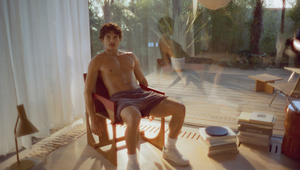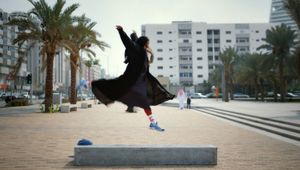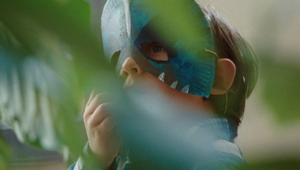
Your Shot: From Crack Pipes to Glass Art

This brilliantly trippy short film is, in the words of director Elisha Smith-Leverock, "a story of transformation and growth - from crack pipes to glass art". The film, created for NOWNESS, takes us on a journey with Jon Gray, the founder of Bronx-based culinary collective Ghetto Gastro, as he works to design his first glassware range in collaboration with a group of world renowned glass-blowing experts in Murano, Venice.
The range of glassware, named Triple Beam Dream in a nod to a 2012 coke ballad from Rick Ross and Nas, is a reference to Jon's past, an homage to the aesthetics of Pyrex glass — a major player in the consumption of crack during the '80s and '90s drug epidemic in New York. Triple Beam Dream serves a beautifully re-imagined iteration of the glassware that he once cooked crack with.
Backing up Elisha's reference-filled visuals is a soundtrack courtesy of Solange - it surfaced that she was a close friend of Jon, and she kindly donated the full instrumental of her most recent album to the project. Ben Smith-Leverock-Esser was the sound designer on the project, weaving Solange's audio into scenes with atmospheric foley.
LBB's Addison Capper chatted with both Ben and Elisha to find out more about the production process.
LBB> When did you first learn of Ghetto Gastro and Jon Gray? How did you come to know about their work?
Elisha> I was really intrigued by their use of food as a form of activism. I first heard about them because the Black Bodies dessert they did to bring awareness to the Black Lives Matter movement and I wanted to find out more. I followed them on Instagram where I then discovered the full extent of their work. When Lief and Katie from NOWNESS approached me to work on this project we jumped at the opportunity straight away.
LBB> How did you approach this project? Going into it, what were your main aims and ambitions and how did you set about achieving them?
Elisha> The outset was to bring together the very traditional creation process and Jon’s personal story in a way that was befitting to him. I wanted to find a way to incorporate the craft elements without becoming too docu style and I really wanted to avoid a talking heads situation.
LBB> How did you work with Jon from a creative and narrative standpoint? Was he quite involved or not?
Elisha> Jon is a truly generous creative mind that gives others space to create as well, so he very much let me take the lead on this.
LBB> Were you quite hands on in directing his performance and voiceover? How did those processes work?
Elisha> Jon was very open with his story and he is a very charismatic and skillful storyteller - therefore I very much wanted to let him tell his story in his own style.
LBB> Can you tell us a bit about Triple Beam Dream as a project and what Jon is doing with it?
Elisha> Just to quote Jon, he wanted to create something he calls ‘Social Sculpture’ by taking something destructive and making something beautiful out of it. Whilst also challenging “who gets to create luxury items, what luxury looks like and what's the history behind it”.
LBB> From an aesthetic point of view, what were you looking to achieve? What were your biggest inspirations when it came to the visuals?
Elisha> Going into the project I made the aesthetic choice to use mixed formats as I thought this might be an interesting way to visually represent the mixture of old and new traditions.
Straight away my mind also went to creating these visual double entendres. TBD is inspired by Jon’s experience of drugs - specifically the use of crack cocaine in his community - and I was looking for visual elements that linked the glass blowing process to the use of crack. Both involve smoke for instance. Some of the compounds used in the glassblowing process bear a resemblance to crack rocks, heat was another connecting factor. I wanted to show images that could be interpreted both ways.
And then there was also room for experimentation and spontaneity. I am lucky to have found a great collaborator in my DOP Olan Collardy.
LBB> What was the production process actually like? Did you travel to Venice and experience the glassmakers at work? What was that like?
Elisha> Yes, that was really very special to be let into that world and to get to see the process and how skillful the masters in Murano are. They made it look so easy. They also put on a little show for us and did some amazing trickery with glass.
I have to say one of my personal highlights was Jon taking us out to eat after the shoot. As you would expect, he knows what’s good!
LBB> Tell me about the music - you got Solange to soundtrack the film, which is amazing. How did you initially get her involved? Was she someone you had in mind from the start or was it more a case of happenstance?
Elisha> We have to thank Jon for that. I was mentioning music and then he casually made the suggestion that he could ask his friend Solange and I was like “OMG YES!!!” Having Solange’s tracks along with Ben’s amazing sound design really elevated the film.
Ben> She actually gave us all the instrumentals from her amazing last album ‘When I Get Home’. I love the production on the record so just hearing the instrumentals was a real pleasure for me! Some parts I slowed down, looped, chopped, etc. but mostly I just arranged sections from the tracks that I thought worked in each scene.
LBB> What was the sound design process like once you had the soundtrack? What kind of atmosphere were looking to create?
Ben> There were two parts to it basically. Finding / creating the foley sound - atmospheric, room sounds, etc. - and then the more creative stuff like the shimmering of the crystals falling, the warping ocean sounds and psychedelic glass blowing.
There are sections which move quite suddenly from this trippy, hazy feeling to being right there up and close with Jon in Venice so that was fun to play with that sonically.
Also I find it's about leaving things to the imagination because otherwise there's just so much information with the picture, VO and sound design, so space was really important in the sound design too.
LBB> How do you find the process of collaborating on projects like these as a married couple?
Ben> It’s nice. Elisha has a real vision for what she wants in music and sound, so we often sit down together on things and work very collaboratively. I get sneak previews of work in progress and a real insight into her process which informs the musical process.
LBB> Do you feel that adds any kind of dimension to the finished production or is it a case of you both doing what you are used to doing?
Ben> The work I’ve done that I’m most proud of has always come about through collaboration. I really believe that's the key to creating unique work, having a creative dialogue and being pushed to do something that you wouldn’t instinctively do on your own. And as a married couple we’re also able to speak pretty frankly with each other… that can sometimes be an asset.















